In an increasingly complex security landscape, the importance of implementing proactive measures cannot be understated. Video surveillance systems have emerged as vital in deterring and preventing criminal activities.
This article explores the necessity of video surveillance systems, highlighting their benefits and applications in various settings.
Understanding the Security Landscape
With increasing security threats and incidents, organizations must take proactive steps to safeguard their premises and assets. A comprehensive security approach involves reactive measures and preventive strategies to mitigate risks and protect against potential threats.
Benefits of Video Surveillance Systems
Video surveillance systems offer numerous advantages that contribute to overall security and safety:
- Their mere presence acts as a powerful deterrent to potential wrongdoers. Knowing their actions are being recorded can dissuade criminals from targeting a location.
- Video footage is crucial evidence in investigations and prosecutions, increasing the chances of identifying and apprehending perpetrators.
- Real-time monitoring through video surveillance enhances situational awareness and enables swift response in case of any suspicious activity or emergency.
Industries and Settings That Require Video Surveillance
Video surveillance systems find applicability across various industries and settings. In retail establishments, these systems help mitigate theft, shoplifting, and vandalism, providing a sense of security for both customers and employees. Corporate offices rely on video surveillance to protect sensitive information and assets, preventing unauthorized access. Manufacturing facilities utilize video surveillance to ensure employee safety and avoid equipment damage. Educational institutions prioritize video surveillance for enhanced campus security and proactive incident prevention.
Public spaces like parks and transportation hubs benefit from video surveillance systems as they safeguard public safety and deter criminal activities.
Customization and Scalability of Video Surveillance Systems
Video surveillance systems can be customized to meet different environments’ specific needs and requirements. Organizations can tailor the number and placement of cameras and the coverage area to ensure comprehensive monitoring.
Additionally, these systems can be integrated with other security technologies, such as access control systems, creating a unified security ecosystem. The scalability of video surveillance systems allows organizations to expand coverage as needed, ensuring that their security needs are met even as their operations grow or change.
Advanced Features and Technologies in Video Surveillance Systems
Video surveillance systems have evolved significantly, incorporating advanced features and technologies. High-definition (HD) and Ultra HD (4K) video quality provides clear and detailed footage, aiding identification and evidence gathering.
Pan-tilt-zoom (PTZ) cameras offer flexibility in monitoring and tracking subjects of interest. Video analytics, another key component, involves the application of intelligent algorithms for automated monitoring and event detection.
These analytics can detect and alert security personnel to specific behaviors or events, enhancing the efficiency and effectiveness of the monitoring system. Cloud-based storage and remote access options provide convenience and flexibility in data management, allowing authorized personnel to access footage from anywhere at any time.
Applications of Video Analytics
The application of video analytics is a critical component of modern video surveillance systems since it enables advanced capabilities beyond basic monitoring.
Using artificial intelligence (AI) and machine learning algorithms, video analytics can automatically detect and analyze various events or behaviors in real time. This includes identifying unauthorized access, loitering, object left behind, or abnormal crowd behavior.
By leveraging video analytics, organizations can enhance their proactive monitoring capabilities and receive immediate alerts for potential security breaches or safety incidents.
Compliance and Legal Considerations
Organizations must navigate privacy regulations while implementing video surveillance systems and ensure lawful surveillance practices. It is important to strike the right balance between security needs and individual rights.
Compliance with industry-specific regulations and requirements is also crucial to ensure the legal operation of the surveillance system. Additionally, organizations must implement appropriate data protection and retention policies to safeguard the privacy and security of captured video footage.
Case Studies and Success Stories
Numerous organizations across industries have successfully implemented video surveillance systems to improve their security posture.
Case studies demonstrate the positive impact of video surveillance, showcasing incidents where timely detection and intervention prevented theft, vandalism, or other criminal activities. These success stories highlight the effectiveness of video surveillance systems in deterring and preventing security incidents.
Addressing Common Concerns and Misconceptions
Despite the benefits, there are common concerns and misconceptions surrounding video surveillance systems.
Privacy concerns often arise, but organizations can balance security and individual rights with proper system configuration and adherence to privacy regulations. Maintenance and system reliability are also important considerations, and regular maintenance and support ensure the continuous operation and effectiveness of the video surveillance system.
Furthermore, video surveillance systems are often perceived as costly; however, long-term cost savings can be achieved through loss prevention, remote monitoring capabilities, and improved incident management.
Future Trends and Innovations in Video Surveillance
Looking ahead, video surveillance systems are expected to continue evolving. Integration with artificial intelligence (AI) technology will enhance video analytics capabilities, allowing for more sophisticated event detection and automated responses. Integrating video surveillance with the Internet of Things (IoT) will create interconnected security ecosystems, enabling data-driven insights and more effective incident management.
Cloud-based video surveillance will streamline data management and accessibility, offering scalability and cost-effective storage options.
Conclusion
In today’s security landscape, video surveillance systems are necessary to protect organizations, individuals, and assets.
Their benefits, including deterrence, evidence collection, and real-time monitoring, make them essential to comprehensive security strategies. From retail establishments to corporate offices and manufacturing facilities to educational institutions, video surveillance systems provide a crucial layer of protection.
By embracing advancements in technology and staying compliant with legal considerations, organizations can leverage video surveillance to enhance security, improve incident response, and ensure the safety of their environments.


